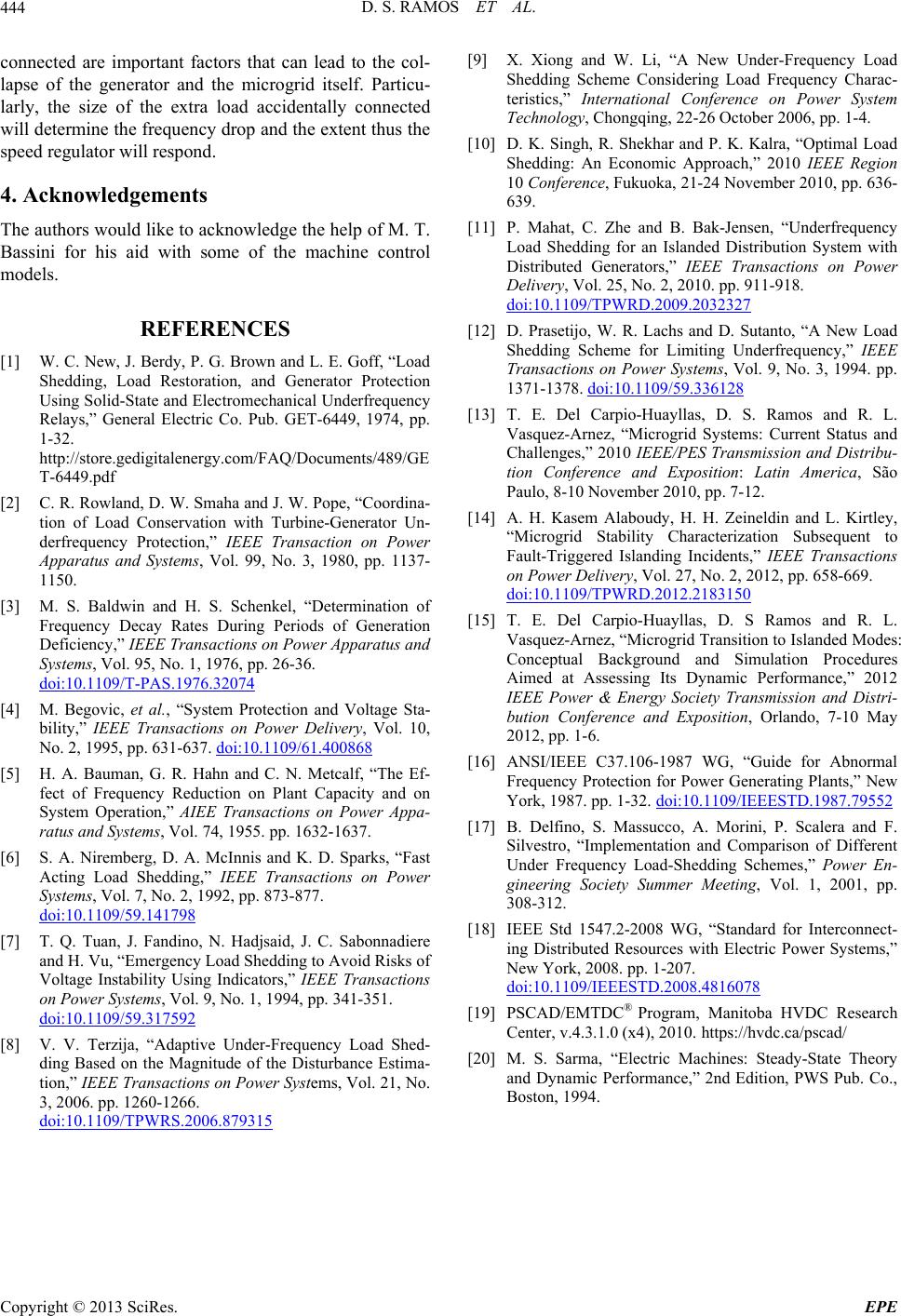
D. S. RAMOS ET AL.
Copyright © 2013 SciRes. EPE
444
connected are important factors that can lead to the col-
lapse of the generator and the microgrid itself. Particu-
larly, the size of the extra load accidentally connected
will determine the frequency drop and the extent thus the
speed regulator will respond.
4. Acknowledgements
The authors would like to acknowledge the help of M. T.
Bassini for his aid with some of the machine control
models.
REFERENCES
[1] W. C. New, J. Berdy, P. G. Brown and L. E. Goff, “Load
Shedding, Load Restoration, and Generator Protection
Using Solid-State and Electromechanical Underfrequency
Relays,” General Electric Co. Pub. GET-6449, 1974, pp.
1-32.
http://store.gedigitalenergy.com/FAQ/Documents/489/GE
T-6449.pdf
[2] C. R. Rowland, D. W. Smaha and J. W. Pope, “Coordina-
tion of Load Conservation with Turbine-Generator Un-
derfrequency Protection,” IEEE Transaction on Power
Apparatus and Systems, Vol. 99, No. 3, 1980, pp. 1137-
1150.
[3] M. S. Baldwin and H. S. Schenkel, “Determination of
Frequency Decay Rates During Periods of Generation
Deficiency,” IEEE Transactions on Power Apparatus and
Systems, Vol. 95, No. 1, 1976, pp. 26-36.
doi:10.1109/T-PAS.1976.32074
[4] M. Begovic, et al., “System Protection and Voltage Sta-
bility,” IEEE Transactions on Power Delivery, Vol. 10,
No. 2, 1995, pp. 631-637. doi:10.1109/61.400868
[5] H. A. Bauman, G. R. Hahn and C. N. Metcalf, “The Ef-
fect of Frequency Reduction on Plant Capacity and on
System Operation,” AIEE Transactions on Power Appa-
ratus and Systems, Vol. 74, 1955. pp. 1632-1637.
[6] S. A. Niremberg, D. A. McInnis and K. D. Sparks, “Fast
Acting Load Shedding,” IEEE Transactions on Power
Systems, Vol. 7, No. 2, 1992, pp. 873-877.
doi:10.1109/59.141798
[7] T. Q. Tuan, J. Fandino, N. Hadjsaid, J. C. Sabonnadiere
and H. Vu, “Emergency Load Shedding to Avoid Risks of
Voltage Instability Using Indicators,” IEEE Transactions
on Power Systems, Vol. 9, No. 1, 1994, pp. 341-351.
doi:10.1109/59.317592
[8] V. V. Terzija, “Adaptive Under-Frequency Load Shed-
ding Based on the Magnitude of the Disturbance Estima-
tion,” IEEE Transactions on Power Systems, Vol. 21, No.
3, 2006. pp. 1260-1266.
doi:10.1109/TPWRS.2006.879315
[9] X. Xiong and W. Li, “A New Under-Frequency Load
Shedding Scheme Considering Load Frequency Charac-
teristics,” International Conference on Power System
Technology, Chongqing, 22-26 October 2006, pp. 1-4.
[10] D. K. Singh, R. Shekhar and P. K. Kalra, “Optimal Load
Shedding: An Economic Approach,” 2010 IEEE Region
10 Conference, Fukuoka, 21-24 November 2010, pp. 636-
639.
[11] P. Mahat, C. Zhe and B. Bak-Jensen, “Underfrequency
Load Shedding for an Islanded Distribution System with
Distributed Generators,” IEEE Transactions on Power
Delivery, Vol. 25, No. 2, 2010. pp. 911-918.
doi:10.1109/TPWRD.2009.2032327
[12] D. Prasetijo, W. R. Lachs and D. Sutanto, “A New Load
Shedding Scheme for Limiting Underfrequency,” IEEE
Transactions on Power Systems, Vol. 9, No. 3, 1994. pp.
1371-1378. doi:10.1109/59.336128
[13] T. E. Del Carpio-Huayllas, D. S. Ramos and R. L.
Vasquez-Arnez, “Microgrid Systems: Current Status and
Challenges,” 2010 IEEE/PES Transmission and Distribu-
tion Conference and Exposition: Latin America, São
Paulo, 8-10 November 2010, pp. 7-12.
[14] A. H. Kasem Alaboudy, H. H. Zeineldin and L. Kirtley,
“Microgrid Stability Characterization Subsequent to
Fault-Triggered Islanding Incidents,” IEEE Transactions
on Power Delivery, Vol. 27, No. 2, 2012, pp. 658-669.
doi:10.1109/TPWRD.2012.2183150
[15] T. E. Del Carpio-Huayllas, D. S Ramos and R. L.
Vasquez-Arnez, “Microgrid Transition to Islanded Modes:
Conceptual Background and Simulation Procedures
Aimed at Assessing Its Dynamic Performance,” 2012
IEEE Power & Energy Society Transmission and Distri-
bution Conference and Exposition, Orlando, 7-10 May
2012, pp. 1-6.
[16] ANSI/IEEE C37.106-1987 WG, “Guide for Abnormal
Frequency Protection for Power Generating Plants,” New
York, 1987. pp. 1-32. doi:10.1109/IEEESTD.1987.79552
[17] B. Delfino, S. Massucco, A. Morini, P. Scalera and F.
Silvestro, “Implementation and Comparison of Different
Under Frequency Load-Shedding Schemes,” Power En-
gineering Society Summer Meeting, Vol. 1, 2001, pp.
308-312.
[18] IEEE Std 1547.2-2008 WG, “Standard for Interconnect-
ing Distributed Resources with Electric Power Systems,”
New York, 2008. pp. 1-207.
doi:10.1109/IEEESTD.2008.4816078
[19] PSCAD/EMTDC® Program, Manitoba HVDC Research
Center, v.4.3.1.0 (x4), 2010. https://hvdc.ca/pscad/
[20] M. S. Sarma, “Electric Machines: Steady-State Theory
and Dynamic Performance,” 2nd Edition, PWS Pub. Co.,
Boston, 1994.